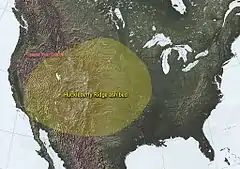Huckleberry Ridge Tuff
The Huckleberry Ridge Tuff is a tuff formation created by the Huckleberry Ridge eruption that formed the Island Park Caldera that lies partially in Yellowstone National Park, Wyoming and stretches westward into Idaho into a region known as Island Park.[1] This eruption of 2,200 km3 (530 cu mi) of material is thought to be the largest known eruption in the Yellowstone Hotspot's history. This eruption, 2.1 million years ago, is the third most recent large caldera forming eruption from the Yellowstone hotspot. It was followed by the Mesa Falls Tuff and the Lava Creek Tuff eruptions.[2]
| Huckleberry Ridge eruption | |
|---|---|
 Huckleberry Ridge ash bed | |
| Volcano | Island Park Caldera |
| Date | 2.1 million years ago |
| Type | Ultra-Plinian |
| Location | Idaho/Wyoming, United States 44.33°N 111.33°W |
| VEI | 8 |
See also
References
- Christiansen, R.L., 2001, The Quaternary and Pliocene Yellowstone Plateau Volcanic Field of Wyoming, Idaho, and Montana: U.S. Geological Survey Professional Paper 729-G, 145 p.
- Yellowstone Caldera, Wyoming
This article is issued from Wikipedia. The text is licensed under Creative Commons - Attribution - Sharealike. Additional terms may apply for the media files.
